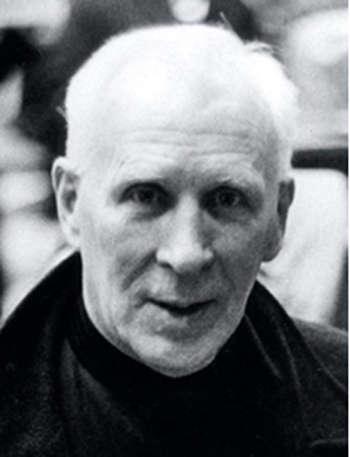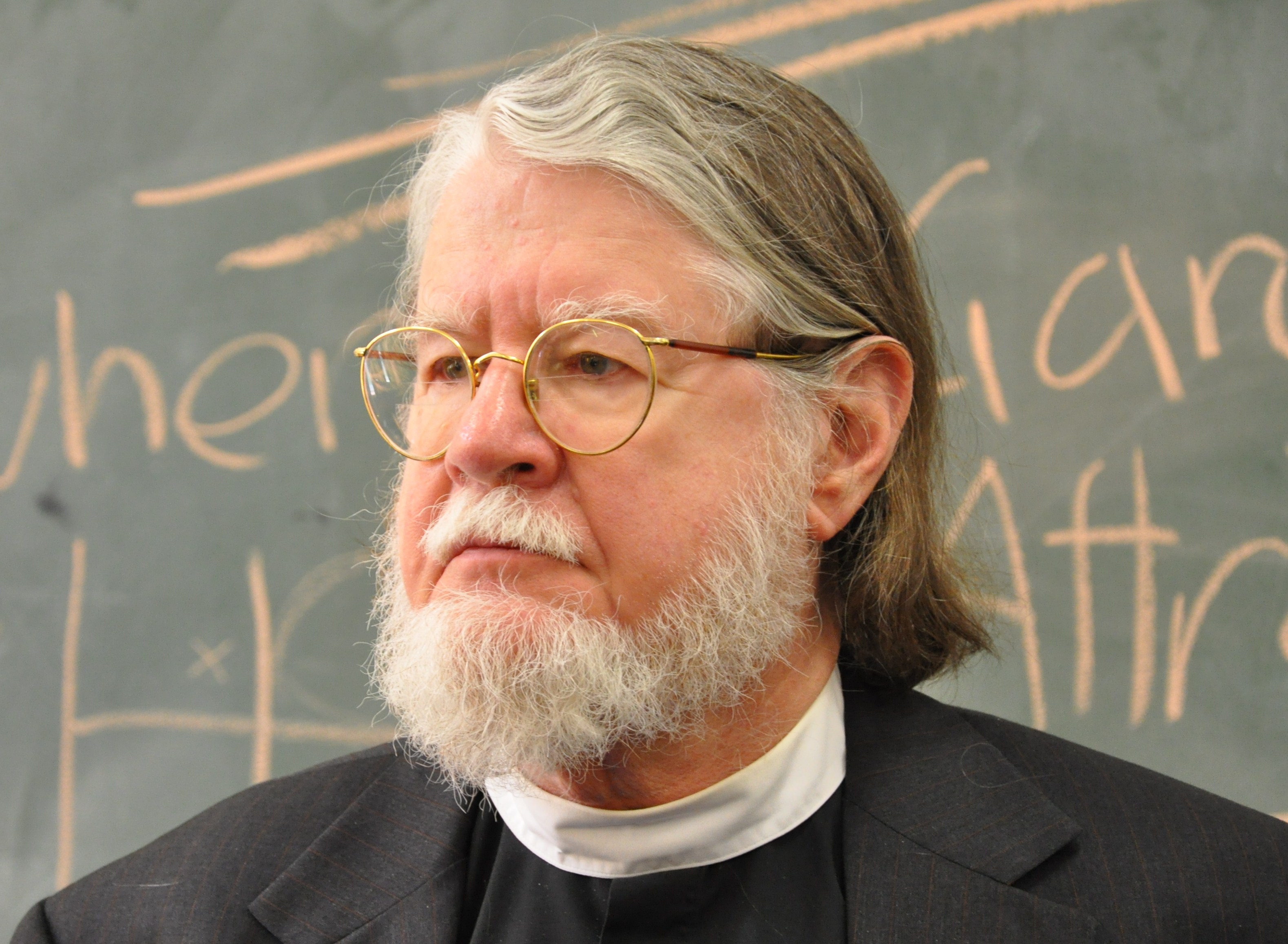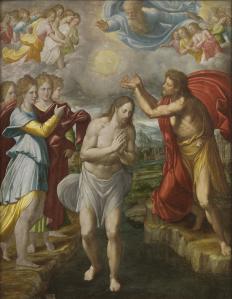Incarnation and the Cross
In On the Incarnation, St. Athanasius sets out to offer an apology for the cross of Christ.He sums up the whole of the Christ-event under the heading of “Incarnation,” rather than limiting the scope the study to the Son of God taking-on human flesh at His birth to the Virgin Mary. That this is the case can be seen in his opening lines: after reminding the reader of what has been said previously in Against the Gentiles, Athanasius states the purpose for the present work:
… let us, with the faith of our religion, relate also the things concerning the Incarnation of the Word and expound his divine manifestation to us, which the Jews slander and the Greeks mock, but we ourselves venerate, so that, all the more from his apparent degradation, you may have an even greater and fuller piety towards him… (Inc., 1)
That “the Incarnation” is connected here with that “which the Jews slander and the Greeks mock” hints for us at what Athanasius has in view. In I Cor. 1:23, Paul uses that description for the crucifixion, not the human birth of Christ. For Athanasius, then, to speak of the incarnation of Christ is to speak of the whole of His work: His birth, career, death, resurrection, and ascension. The Word is made manifest to us as the One who confounds the wisdom of the world, and this chiefly through the cross.
Redemption from Corruptibility and Death
The Incarnate Word is none other than Who created the world, and He becomes man to effect a new creation. Athanasius now addresses, in 2-10, creation and God’s “dilemma” regarding life and death. God created the world “from nothing, and having absolutely no existence God brought the universe into being through the Word…” , and He placed His special grace “upon the human race,” making them in His own image (Inc., 3). The imago Dei comes up later as the basis for the coming of Christ, who is the image of the Father, to recreate man in God’s image (Inc., 13-14).
Through man’s sin, Athanasius says, we fail to obtain incorruptibility: death means “not merely to die, but to remain in the corruption of death.” (3) Through the transgression, corruption “prevailed” against humanity, and the race dove further into it in all manner of wickedness. He cites Paul in Rom. 1:26-27, showing that “[even] acts against nature were not far from them…” (5). Athanasius describes evil as “non-being”; God is the source of all good, and evil is not sourced in Him. In turning toward evil, man has turned toward non-being, and non-being will be the end of corruption.
For this reason, to redeem us from the corruption of death, the Word became man: “For we were the purpose of his embodiment, and for our salvation he so loved human beings as to come and appear in a human body.” Athanasius speaks in eschatological terms, describing the nearness of the end for humanity: “the race of humans was perishing, and the human being [made in the divine image] was perishing, and the work of God was being obliterated.” (6) This work being an apology for the cross, Athanasius demonstrates how what God has done to redeem the world in Christ truly “befitted the goodness of God” (10).
The incarnation (and, included within that, the death and resurrection) of Christ is fully in accord with God’s goodness. Rather than claiming that God would be perfectly just to let the world go to hell, as many do, Athanasius argues that it would be outside of God’s character to abandon His creation. He uses the analogy of a king who built a house or a city rescuing his work from peril. A good king would not abandon his city to ruin at the hands of “bandits” and “careless inhabitants”; much less so would God leave His creation to corruption. A god who does not redeem is not the triune God, for God has sovereignly chosen to be the god who redeems.
Restoring the Imago Dei
God acts in Christ to redeem humanity from death to life, and He also works in Him to restore humanity in the imago Dei. We are made in God’s image in creation, and recreated in God’s image in our redemption. However, for Athanasius, even the original creation of man is not in God’s image in a general sense; man created in God’s image is man in the image of Jesus Christ:
“… he bestowed on them his own image, our Lord Jesus Christ, and made them according to his own image and according to the likeness, so that understanding through such grace the image, I mean the Word of the Father, they might be able to receive through him a notion of the Father, and knowing the Creator they might live the happy and truly blessed life” (11).
Athanasius here establishes the doctrine of the imago Dei as God’s gracious bestowal on man a real participation in the person of the Son, without which any knowledge of the Creator is impossible. Through foolishness and demonic deceit, “despising the grace thus given to them,” turned away from God to darkness and fell from the knowledge of the Father (11). Athanasius cites Paul, showing that this turning away consists in idolatry, worshipping the creation rather than the Creator (Rom. 1.25), and turning further to worship of demons.
It is in light of this “turning away”, this “darkening” of the imago Dei that God works in Christ to renew humanity in the image. “…what was God to do?”, Athanasius asks (13). He follows the same logic regarding the renewal of the imago Dei as earlier, with God’s “dilemma” regarding life and death: just as a king would not let his domain fall by the foolishness of his subjects or deceit from the outside, so it would not befit God’s goodness to let his creatures remain in darkness; “So the Word of God came himself, in order that he being the image of the Father (cf. Col. 1.15), the human being ‘in the image’ might be recreated.” (13). Through the work of Christ, man is recreated in God’s image. The new birth in John 3, Athanasius says, indicates “the soul being born again and recreated in that which is after the image” (14). Union with Christ is a real participation in the Son, the eternal image of the Father.
In the remainder of this section, Athanasius discusses the implications and results of Christ’s incarnation. In renewing humanity in the imago Dei, He banished death and revealed Himself to be ruler and king of the universe (16); in His incarnation, the Son took on a “real and not illusory body”, uniting Himself to humanity and sanctifying the body, previously under the corruption of death (17).
Athanasius then moves on to discuss Jesus’ death and resurrection, recounting “the end of his life and dealings in the body”, by which “Christ is known to be God and Son of God” (19). He has shown already that the fall of man brought the reign of death and corruption, and death was thus “required of all”; the climax of the incarnation, though, is Jesus taking this death on Himself “on behalf of all” (20). Athanasius demonstrates a substitutionary atonement, Jesus giving Himself “in the stead of all,” bearing the completion of death in His own body in order to deliver humanity from death’s reign. Christ’s death gave a double, and paradoxical, effect: “the death of all was completed in the lordly body, and also death and corruption were destroyed by the Word in it.”
Jesus gave Himself over to death on behalf of all, and His resurrection transformed the whole event of the cross into His victory over death. Athanasius speaks beautifully of the many effects of the death and resurrection: the cross became the sign of victory; His body remained undivided to demonstrate that His Church will be one; He stretched out His hands on the cross as He draws Jew and Gentile into one new man in Himself; He was lifted up on the cross to purify the air and open the way to heaven; by His death He truly revealed the Creator to the creatures (24-26).
Proofs of Death’s Defeat
Athanasius offers two main proofs for the defeat of death: the attitude of Christian disciples towards death, and the continued works of Christ in the world.
That death is in fact truly defeated in Christ’s death and resurrection is powerfully demonstrated, Athanasius argues, by the way the disciples approach death: the death of death is shown in that Christians, men, women, and children alike, no longer fear death, but “with the sign of the cross and faith in Christ tread it under foot as something dead” (27). The disciples despising of death attests to Christ as the one who has truly defeated death. Death is naturally feared, but since the death and resurrection of Christ, Christians boldly face death, with the sure confidence in the resurrection. This real change in the believer’s attitude towards death demonstrates a real change in death itself; death has lost its sting, being swallowed up in the victory of Christ (1 Cor. 15.54-55).
The defeat of death and the resurrection of Christ is seen, moreover, in Christ’s continued work in the world of the living. Athanasius states the obvious: “If anyone is dead, he cannot act”; and yet, Jesus is clearly active in the world, particularly in the community of disciples:
“Is it like a dead man to prick the minds of human beings so that they deny their father’s laws and revere the teachings of Christ? Or how, if he is not acting… does he stop those active and alive so that the adulterer no longer commits adultery, the murderer no longer murders, the unjust is [sic] no longer grasps greedily, and the impious is henceforth pious… For where Christ and his faith are named, there all idolatry is purged away, every deceit of demons refuted, and no demon endures the name but fleeing, only hearing it, disappears. This is not the world of one dead, but of one alive, and especially of God” (30).
God is seen by His works, Athanasius argues, and God’s works in and through the Church clearly demonstrate the reality of Christ’s resurrection and continued life.
Refuting Jew and Gentile
Athanasius ties the remainder of the work back to his opening statements; he set out to expound upon the Incarnation of Christ which the Jews slander and the Greeks mock (1), and he now answers the slander and mockery of Jew and Gentile. He demonstrates, against the Jews, that the death and resurrection of Christ fully accords with Scripture, paying special attention to Isaiah’s prophecies that the Messiah would suffer and die for the sake of all, and at the hands of Israel. Against the Gentiles, who mock at the idea of God taking on human flesh, he argues that it is perfectly fitting for the God who created and fills the cosmos to enter into the creation in a human body, “… For the human race is part of the whole; and if the part is unsuitable to be his instrument toward the knowledge of his divinity, it would be most absurd that he should be made known even through the whole cosmos” (41). It is right and fitting, Athanasius argues, that the Creator take on human flesh in order to restore and save His good creation. By this work the body, and the creation as a whole, is sanctified and redeemed.
This leads to Athanasius’ beautiful (and famous) statement of deification:
“For he was incarnate that we might be made god; and he manifested himself through a body that we might receive an idea of the invisible Father; and he endured the insults of human beings, that we might inherit incorruptibility” (54).
The purpose of the Incarnation of the Son of God is to bring about God’s original purpose for humanity: to bring us into the divine life of the Father, Son, and Holy Spirit, that we might join in the eternal fellowship of love in God. Through great pain Jesus entered into our humanity, suffered and passed through death for us, that He might defeat it, delivering us from death’s reign and bringing us into eternal union with Himself.







